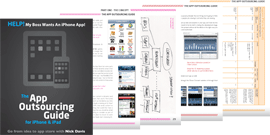The main difference of a larger screen size between iPhone and iPad is obvious enough, but how you use that extra space is important. For most apps, creating a simple ‘upscale’ of your iPhone App is not going to cut it, so you need to think about how you’re going to use that extra screen area in a way that improves the user’s experience.
For some that transition will be obvious. If you’re the creator of Angry Birds you can suddenly show a lot more of the game area at once as well as updating your graphics to a higher resolution1.
For others, it might not be so clear. One approach used in a lot of iPad apps is to take that extra space and create two or three distinct areas on the page, as opposed to iPhone apps where there tends to be just one main area only. For example on an iPad news app you could have one large area of the page that shows the current article or video being viewed and another which could show all the sections of the app (ie. the whole navigation) on- screen all the time.This would differ from an iPhone App where the article or video takes up most of the page and the only real navigation option might be a ‘Back’ button. In this way an iPad user may have a better experience (easier navigation) than a user on an iPhone.This is just one example of how simply upscaling the app for the iPad would not deliver the same benefit to a user as slightly re-thinking the concept for the tablet device.
Something else you might want to consider is that the larger space on an iPad can let you support gestures from more than one user at a time. For example, in a game (eg ‘MultiPong’ touchreviews.net/multipong-ipad-pong-game/) two players could be playing – touching the screen – at the same time.
If you’re planning on designing a great iPad App, you should be very familiar with the device and the leading apps for it. iPad is still a developing medium though so the number of good ideas is certainly not saturated by any means so there is even more incentive for doing something new and original.
I also strongly advise that later in the project (as soon as you are getting working builds of the app to test) you get people outside your project group to test the iPad app’s gestures and navigation. Unlike on iPhone Apps where navigation and gestures are now fairly standardised, on iPad the platform is still relatively young and there are many cases of apps not being interpreted or understood by users in the way the original creator intended.
Keep an eye out too for any new pieces of research and studies on iPad user behaviour that may help you in your design decisions.You may also want to take a look at Apple’s ‘iPad Human Interface Guidelines’ which highlight some of the extra considerations of developing for the platform.
- iPad Human Interface Guidelines
- iPad Usability: First Findings From User Testing’ Jakob Nielsen
- iPad Usability, free 93-page downloadable report from Nielsen Norman Group
